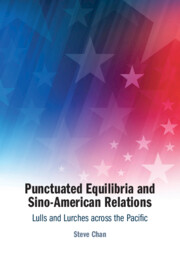
-
Select format
-
- Publisher:
- Cambridge University Press
- Publication date:
- 25 July 2025
- 14 August 2025
- ISBN:
- 9781009634502
- 9781009634489
- 9781009634465
- Dimensions:
- (228 x 152 mm)
- Weight & Pages:
- 0.589kg, 296 Pages
- Dimensions:
- (228 x 152 mm)
- Weight & Pages:
- 0.42kg, 296 Pages
You may already have access via personal or institutional login
Book description
In many areas of the natural and physical world, long periods of seeming stasis or small incremental changes are interrupted by large, sudden leaps. This book illustrates how similar processes characterize international relations. This book points to such occurrences, for example the collapse of the USSR, the unravelling of Napoleon's wartime alliance, and the possible future status of the US dollar; and it illustrates in greater detail the admission of China to the United Nations, the history of economic development of various countries, and the possible formation of a countervailing coalition against US primacy. Steve Chan investigates these instances and explains the dynamics governing these processes of lulls and lurches and illuminates how qualitative research can apply the Boolean logic to study systematically the danger of a possible future Sino-American conflict based on past episodes.
Contents
Metrics
Altmetric attention score
Full text views
Full text views help Loading metrics...
Loading metrics...
* Views captured on Cambridge Core between #date#. This data will be updated every 24 hours.
Usage data cannot currently be displayed.
Accessibility standard: Missing or limited accessibility features
Why this information is here
This section outlines the accessibility features of this content - including support for screen readers, full keyboard navigation and high-contrast display options. This may not be relevant for you.
Accessibility Information
The PDF of this book is known to have missing or limited accessibility features. We may be reviewing its accessibility for future improvement, but final compliance is not yet assured and may be subject to legal exceptions. If you have any questions, please contact accessibility@cambridge.org.
Content Navigation
Table of contents navigation
Allows you to navigate directly to chapters, sections, or non‐text items through a linked table of contents, reducing the need for extensive scrolling.
Index navigation
Provides an interactive index, letting you go straight to where a term or subject appears in the text without manual searching.
Reading Order and Textual Equivalents
Single logical reading order
You will encounter all content (including footnotes, captions, etc.) in a clear, sequential flow, making it easier to follow with assistive tools like screen readers.
Visualised data also available as non‐graphical data
You can access graphs or charts in a text or tabular format, so you are not excluded if you cannot process visual displays.
Visual Accessibility
Use of colour is not sole means of conveying information
You will still understand key ideas or prompts without relying solely on colour, which is especially helpful if you have colour vision deficiencies.
Use of high contrast between text and background colour
You benefit from high‐contrast text, which improves legibility if you have low vision or if you are reading in less‐than‐ideal lighting conditions.

